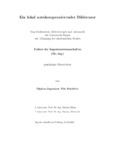Citation link:
https://nbn-resolving.org/urn:nbn:de:hbz:467-2172Files in This Item:
| File | Description | Size | Format | |
|---|---|---|---|---|
| friedrich.pdf | 6.82 MB | Adobe PDF |  View/Open |
| Dokument Type: | Doctoral Thesis | metadata.dc.title: | Ein lokal autokompensierender Bildsensor | Authors: | Friedrich, Nils | Institute: | Fachbereich 12, Elektrotechnik und Informatik | Free keywords: | lokal autokompensierender Bildsensor, LACS, CMOS-Bildsensor | Dewey Decimal Classification: | 620 Ingenieurwissenschaften und Maschinenbau | GHBS-Clases: | YFBK | Issue Date: | 2006 | Publish Date: | 2006 | Abstract: | Die vorliegende Dissertation beschreibt die Entwicklung und Implementierung des lokal autokompensierenden Bildsensors LACS ( L ocally A uto C ompensating I mage S ensor). Eine der größten Herausforderungen beim Entwurf von CMOS-Bildsensoren ist prinzipiell die Kombination einer hohen Empfindlichkeit mit einem weiten Dynamikbereich. Beide Attribute sind Voraussetzungen für die Detektion schwacher Lichtsignale in der Umgebung starker optischer Störsignale, die daher zu widersprüchlichen Anforderungen an einen Bildsensor führen. Detaillierte Untersuchungen verschiedener hochdynamischer Sensorsysteme zeigen, daß zusätzliche Rauschbeiträge die erzielte Dynamikerweiterung stark einschränken. Der intelligente Bildsensor LACS blendet auftretende Störbeleuchtung aus, indem der entsprechende Anteil des Photostroms pixelweise automatisch kompensiert wird. Auf diese Weise steht eine hohe Empfindlichkeit zur Verfügung, ohne daß der Dynamikumfang reduziert wird. Die Eigenschaften der Pixel- sowie Peripherieelektronik des LACS werden mit Hilfe von numerischen Simulationen und analytischen Modellen beschrieben. Die Untersuchung von zeitlichem und örtlichem Rauschen sowie die Analyse von Nichtidealitäten des LACS-Pixels stehen dabei im Vordergrund. Während sich das Photonenrauschen als dominante Quelle zeitlichen Rauschens herausstellt, bestimmen die räumlichen Schwankungen des Kompensationsstroms die physikalischen Grenzen des Sensors. Die mit der ersten lokal autokompensierenden Kamera aufgenommenen Bilder bestätigen die Funktionalität des autokompensierenden Konzepts sowie die Ergebnisse der theoretischen Betrachtungen. Die Kamera generiert die erforderlichen Steuersignale und transferiert die aufgenommenen Bildsignale an einen Rechner. Der LACS-Prototyp wurde in einem 0,35 µm-CMOS-Prozeß realisiert und besteht aus 32 × 32 Pixeln. Die Pixelelektronik umfaßt neun Transistoren und zwei Kapazitäten. Die Pixelfläche beträgt insgesamt (38 µm) 2 . Die Peripherieelektronik des LACS verfügt über eine Schaltung zur korrelierten Doppelabtastung ( C orrelated D ouble S ampling, CDS), die eine Reduzierung von Fixed Pattern Noise (FPN) ermöglicht. This Ph.D. thesis describes the development and implementation of the image sensor LACS ( L ocally A uto C ompensating I mage S ensor). One of the most challenging problems in designing CMOS image sensors is the combination of high sensitivity and wide dynamic range. Both are required for the detection of weak optical signals that are surrounded by bright ambient light, which principally leads to contradictory demands on the image sensor design. Various dynamic range enhancing concepts are analysed. It can be shown, that the apparently achieved dynamic range enhancement is largely limited by additional noise contributions. The intelligent image sensor LACS suppresses ambient light by automatically compensating the corresponding part of the photo current. Thus, a high sensitivity is provided for the detection of weak signals without limiting the dynamic range of the captured scene. The characteristics of the LACS-pixel and the sensor’s periphery are described using numerical simulations and analytical models. Emphasis is placed on the analysis of noise and fixed pattern noise (FPN) as well as the deviation of the compensating current from ideal behaviour. While photon shot noise turns out to be the dominant noise source, the sensor’s performance is mainly determined by the FPN of the compensation current. Sample images taken by the first autocompensating camera validate the functionality of the locally autocompensating concept as well as the results from calculations and simulations. The camera provides the control signals and transfers the achieved data to a computer. The LACS-prototype was realized using a 0.35 µm-CMOS process and consists of 32 × 32 pixels. Each pixel measures (38 µm) 2 and includes nine transistors and two capacitances. Random access is provided as well as correlated double sampling (CDS) to reduce fixed pattern noise. |
URN: | urn:nbn:de:hbz:467-2172 | URI: | https://dspace.ub.uni-siegen.de/handle/ubsi/217 | License: | https://dspace.ub.uni-siegen.de/static/license.txt |
| Appears in Collections: | Hochschulschriften |
This item is protected by original copyright |
Page view(s)
363
checked on Jan 4, 2025
Download(s)
300
checked on Jan 4, 2025
Google ScholarTM
Check
Items in DSpace are protected by copyright, with all rights reserved, unless otherwise indicated.

